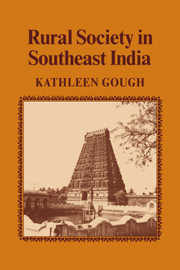Book contents
18 - East Thanjāvūr
from Part III - Kirippūr
Published online by Cambridge University Press: 29 October 2009
Summary
In 1951 East Thanjāvūr comprised the tālūks of Sīrkāḷi, Mayuram, Naṉṉilam, Maṉṉārgudi, Nāgapaṭṭanam, and Tirutturaipūndi; West Thanjāvūr, those of Kumbakōnam, Pāpaṉāsam, Thanjāvūr, Paṭṭukkoṭṭai, and Arantāngi.
From its inception in the 1930s until the present, the Communist movement in the countryside has been far more prominent in East Thanjavur than in the west. In 1951, Nāgapattanam tālūk was the center of the movement, with Naṉṉilam and northern Maṉṉārgudi the next most prominent areas, and Sīrkāḷi, Māyuram, and northern Turuttaraipūndi peripheral regions. These areas comprised the eastern region of the old delta. The movement was much weaker in the western part of the old delta (Kumbakōnam, Pāpaṉāsam, and the northern part of Thanjāvūr tālūk) and almost nonexistent in the dry and new delta areas of south Thanjāvūr, south Maṉṉārgudi, Paṭṭukkoṭṭai, and Arantāngi, and in the southern salt swamp of Tirutturaipūndi.
Historical circumstances and local leadership had played a role in this development. Communist organizing among poor tenants and agricultural laborers began with conferences in 1938 at Kīlvelur and Nāgapaṭṭaṇam, and the movement remained strongest in that area subsequently. Nevertheless, the success of Communist organizing in the villages of East Thanjavur undoubtedly was influenced by ecological and socioeconomic factors.
In a valuable article, André Béteille has argued that the Communist movement in Thanjāvūr has been strongest in areas where the landless or near-landless agricultural workforce is most numerous and most homogeneous with respect to both caste and class.
- Type
- Chapter
- Information
- Rural Society in Southeast India , pp. 339 - 352Publisher: Cambridge University PressPrint publication year: 1982

